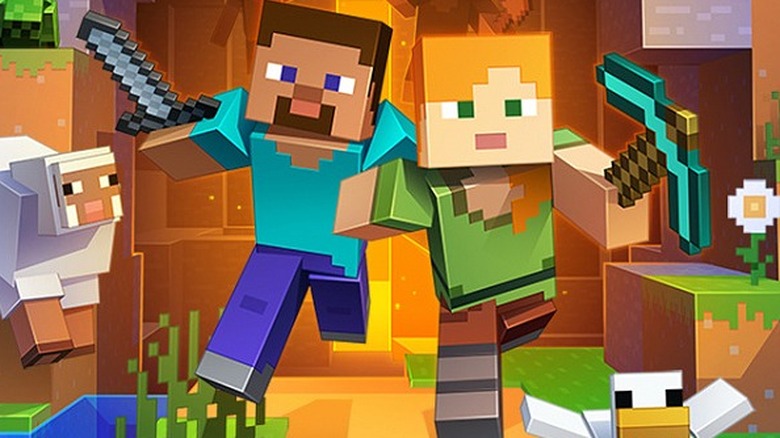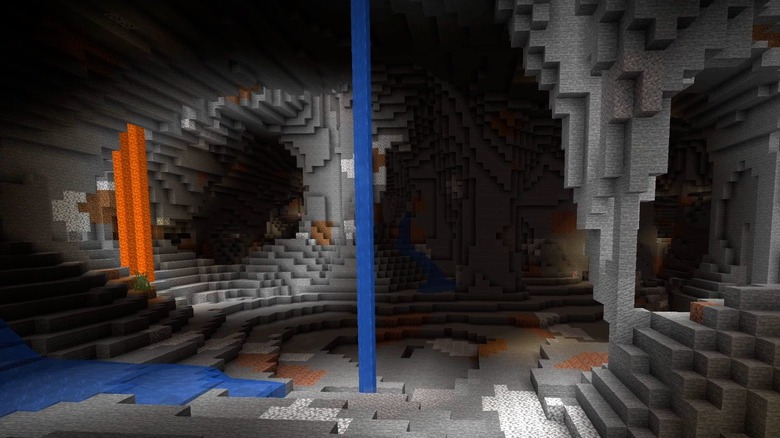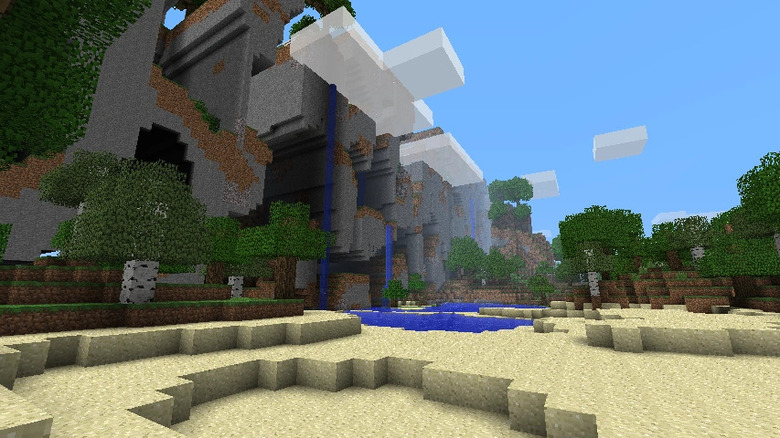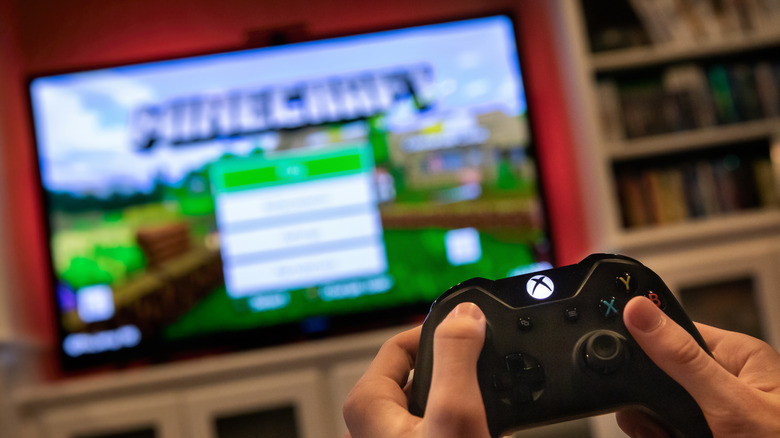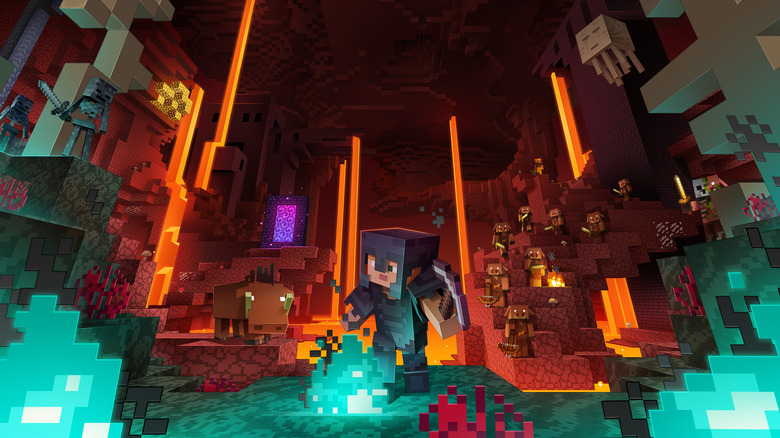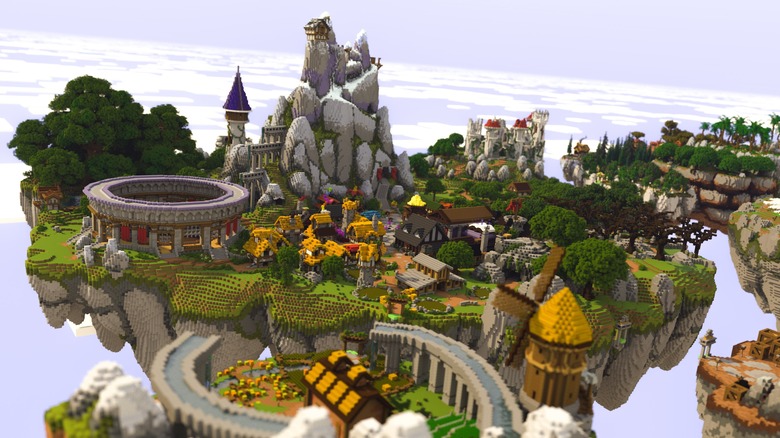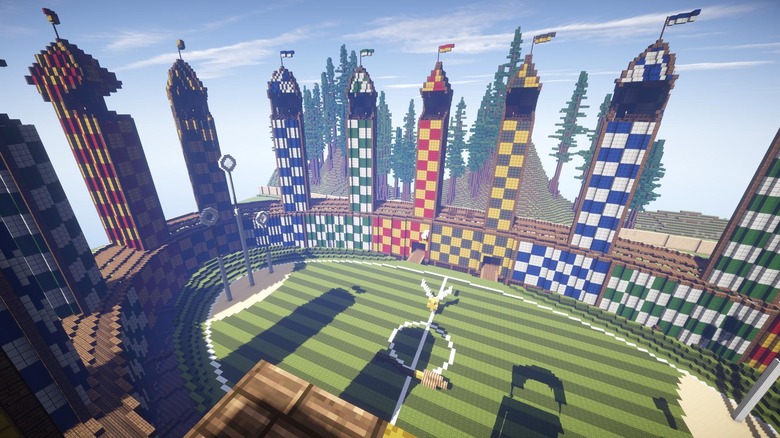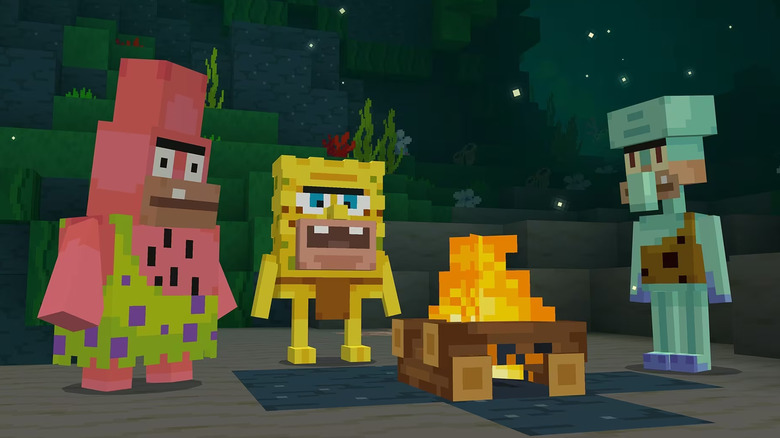The Evolution Of Minecraft, The Best-Selling Video Game In History
Block by block, "Minecraft" has built itself over the years into one of the most recognizable gaming brands worldwide. With over 200 million copies of the game sold, "Minecraft" is the best-selling video game in history. Despite a trashing from its original creator, Notch, "Minecraft" is still going strong in 2023. The New York Times aptly coined a phrase to describe its youthful player base, "The Minecraft Generation," while Polygon called "Minecraft" the "most important game of the decade" — and there's good reason for that.
But what is it about "Minecraft" that's enabled it to become a global phenomenon? What changed about "Minecraft" over the years, and how did it keep a grip on so many people? At its core, "Minecraft" taps into the creative potential of its players like no other game. Diving into the game's origins, its long history of updates, and its wide-ranging community will provide further context for understanding the extraordinary evolution of "Minecraft."
Cave Game origins
"Minecraft's" embryonic state, "Cave Game," sprang from humble origins in May 2009. With only a single-man development team to begin with, Markus "Notch" Persson used the resources he had on hand. Namely, he had been working on a game called "RubyDung," the details of which have never quite seen the light of day. The pixel art for cobblestone and grass blocks created for "RubyDung" were transplanted into the initial "Cave Game" build, giving it a singular look.
Never released to the public, the first "Cave Game" build was reportedly finished on May 13, 2009. The game consisted only of the aforementioned grass and cobblestone blocks on a flat floating island. Breaking and placing blocks existed, but their mapped controls were reversed from what fans now know, with right-click to break and left-clock to place. According to an interview with PCGamer in 2010, "RubyDung" and "Cave Game" took inspiration from the likes of "Dwarf Fortress," "Rollercoaster Tycoon," "Dungeon Keeper," and "Infiniminer." These classics share the user-generated flexibility that "Minecraft" would end up mastering.
Initial versions of Minecraft
Just a few days after "Cave Game's" genesis, on May 17, 2009, Notch released the Classic version of "Minecraft" on the TIGSource forums. Notably, the Classic version introduced dirt, stone, water, and lava blocks, as well as some environmental variety with trees, hills, and lakes.
The strength of the "Minecraft" community started taking shape this early, as Notch's TIGSource forum and blog posts were vehicles for community feedback. The Survival Test development stage introduced its namesake: Survival Mode. Before this update, only Creative Mode was playable. Perhaps most importantly, Survival Mode came with enabled multiplayer. With only a fist to punch trees and a host of spiders, skeletons, and creepers to ward off, the multiplayer Survival Mode brought "Minecraft" closer to its contemporary incarnation.
December 2009 saw the kick-off for "Minecraft's" Indev (a.k.a. "in-development") stage. This first paid version of "Minecraft" instituted many gameplay cornerstones still used today. The use of tools, weapons, and food coincided with the new additions of crafting and smelting. Further updates continued in 2010 with the Infdev("infinite development") stage. Procedurally-generated terrain meant that "Minecraft" was no longer a world with typical boundaries.
"Minecraft's" Alphastage was released on June 30, 2010, along with a host of bug fixes and the addition of the Nether realm. Between June and September 2010, Notch released "Seecret Updates" every Friday. These game finally entered its Beta stage in December 2010, then incubated for less than a year before its official launch.
Mojang officially releases Minecraft
Notch began developing "Minecraft" in 2009 while he was still working a day job at jAlbum, a cross-platform photo website. The popularity of "Minecraft" really started to take off with the release of its Alpha in 2010. At that point, over 20,000 people had already purchased the game. This success prompted Notch to work full-time on it and make long-term decisions about the game's future. On September 6, 2010, Notch posted on Tumblr his plans of "hiring some people, getting an office, and all that!"
Mojang Studios took shape under the banner of Mojang AB, with Notch still as the creative lead behind "Minecraft." With only a few other employees at the time — a CEO, a business developer, an art director, and a lead programmer — Mojang AB was still a small independent team looking to flesh out its premiere title.
After nearly a year in its Beta stage, "Minecraft" officially launched during MineCon on November 18, 2011. It cost $26.95, but players who'd purchased an Alpha or Beta copy received the game for free via an update. "Minecraft" already had a decent amount of hype, but following its official release, sales for the game skyrocketed. "Minecraft" sold more than 4 million copies in just a single year on the market. While the game's success blossomed, internal changes within Mojang led its lead programmer, Jens Bergensten, to take creative control of "Minecraft."
Microsoft acquires Mojang
In a surprising turn of events, following years of sustained success for "Minecraft," Notch wanted out. Following a spat with "Minecraft" users over enforcing new end-user-license agreements, Notch posted a tweet signaling the end of his interest in Mojang and "Minecraft."
Anyone want to buy my share of Mojang so I can move on with my life? Getting hate for trying to do the right thing is not my gig.
— notch (@notch) June 17, 2014
Shortly after posting that tweet, according to a retrospective interview by Forbes, Mojang's CEO received offers from Microsoft, Activision Blizzard, and Electronic Arts. After ruling out EA and Activision Blizzard for unspecified reasons, lawyers between Microsoft and Mojang started hammering out a deal. On September 15, 2014, Microsoft announced its $2.5 billion purchase of Mojang. Some at the time thought Microsoft was overpaying for the right to do what it wanted with the "Minecraft" IP in the future.
Notch was fully paid for his 71% stake in Mojang and became a Forbes World Billionaire. He expected more backlash to his decision to sell, something he railed against earlier in his career. In any case, Notch got his desired exit and payday, and Microsoft acquired what would become the best-selling video game of all time.
Early major updates
A primary reason why "Minecraft" has remained so popular through the years is due to how consistently it's updated and expanded. Not only does "Minecraft" introduce new mechanics, modes, and assets, but it does so free of charge.
One major early update in 2013 was the 1.5 Redstone Update patch. The addition of comparators, hoppers, droppers, daylight sensors, trapped chests, weighted pressure plates, and blocks of Redstone opened up a whole new world of Redstone manipulation within the game. Average players used Redstone for basic automation, creating doors that open and close with corresponding pressure plates. Redstone engineers, however, went even further, with one YouTuber going so far as to create a playable version of "Minecraft" within a Redstone computer built within "Minecraft" itself. So meta!
Another major early update worth highlighting was the 1.9 Combat Update. Released in February 2016, the Combat Update changed the raw mechanics of "Minecraft" combat from button-spamming to charged and timed attacks. Alongside a long list of item and mechanic rebalancing, 1.9 also introduced weapon dual-wielding. Players could also now glide with the use of Elytra. As more time passes, more and more high-quality content makes its way into "Minecraft," improving on everything that's come before.
The updates continue
June 2017 saw the World of Color Update 1.12 populating "Minecraft" realms with more vibrancy, with 16 new brightly-colored dye options for Concrete and Glazed Terracotta greatly expanding "Minecraft's" color palette. Following its release, Reddit users hosted a building competition to showcase the game's new colorful potential.
The Village and Pillage 1.14 Update in 2019 offered even more drastic changes that had a massive impact on typical "Minecraft" experiences. Raid mechanics were fun additions for players who like to team up, as were the enormous list of added blocks, creatures, and items. However, changes to the game's trading economy (thanks to the introduction of Wandering Traders) made the acquisition of hard-to-get items much more doable. The Nether Update 1.16 in 2020 remade the entire Nether realm, giving players five new biomes, five mobs, a new form of trading, and even an upgrade to diamonds.
Most noticeable of all later updates, Caves and Cliffs, was split into two parts: 1.17 and 1.18. The first part of this expansion introduced the most new blocks of any update, while the second installment restructured terrain generation at its core and incorporated those newly-added blocks, mobs, and items into new biomes. Overall, the game's updates have only grown in scope and quality with time, always breathing new life into "Minecraft."
The rise of a speedrunning community
One sure sign that a game has made a lasting impact on the larger culture is when a speedrunning community forms around it. Speedrunners are known for hyper-obsessing over the most granular details to gain minor advantages and cut down their completion time in a game, and the "Minecraft" community is no stranger to this hardcore fan behavior. In fact, "Minecraft" was so enthralling from its beginning that Diamond-acquiring speedruns began when Diamonds were first added to "Minecraft" in 2010.
The addition of the Ender Dragon and an "ending" for the game with the game's official release provided an obvious target for speedrunners. As a result, many categories for speedrunning towards the Ender Dragon have existed over the years. The main distinction between different speedrunning leaderboards comes down to glitched vs. glitchless runs. As their names imply, glitched speedruns don't care how the Ender Dragon is slain, as long as the result is a dead monster. Glitchless runs, on the other hand, require speedrunners to follow all the game's standard rules. As of April 2023, the glitchless world record completion time for Version 1.16+ is under 8 minutes.
Legitimacy is a constant sticking point for speedrunning communities. "Minecraft" experienced its own speedrunning scandal in 2021 when uber-popular YouTuber Dream was caught cheating in his submitted world record run. An in-depth investigation was required to prove that Dream's run was tool-assisted, which he claims was done by accident. Indeed, a harsh lesson — don't mess with the "Minecraft" speedrunning community!
Modding community
One might expect a game based centrally on user creativity to support mods, and for PC users with the Java Edition of "Minecraft," that is absolutely the case. Modders have been cracking away at "Minecraft" ever since the release of the Classic version in 2009. Possibly the first "Minecraft" mod to ever exist, a custom world-generation mod, was noticed in December 2022 by YouTuber MCBYT. These days, "Minecraft" supports a massive modding community, with some of it's most well-known mods receiving millions of downloads.
Entire server networks have developed and tied themselves together through mods. One of the most notable "Minecraft" server networks, Hypixel, is responsible for spawning innovative games within "Minecraft," including SkyBlock, SkyWars, Bed Wars, The Pit, and more. Hypixel's Hunger Games, emerging in 2012, helped spur on the popularity of the Battle Royale genre. The server peaked at 216,000+ concurrent players in 2016. In 2023, it still averages 50,000+ concurrent players.
Another notable "Minecraft" modding community is the storied 2b2t realm. With hardly any rules and no server resets since 2010, 2b2t stand out as a living history book of the game's most talented (and sometimes most toxic) modders. YouTube channels like FitMC have done marvelous work detailing the storied server's history of griefers, territorial kings, hidden bases, and more. Without a doubt, the "Minecraft" modding community continues to breathe new life into an already amazing experience.
Roleplaying is a huge part of Minecraft
"Minecraft" is, first and foremost, a sandbox survival game. However, there are RPG elements of character progression and world immersion, which help "Minecraft" to be more personable than other sandbox-style games. "Minecraft's" first-person POV, for instance, connects players on a human level to the realm. Roleplaying servers take the best RPG elements and run wild with mods and sheer imagination.
A significant impetus for "Minecraft's" surge in popularity in 2020 was the success of the Dream SMP (survival multiplayer) server. Founded by Dream and GeorgeNotFound, the roleplaying server quickly added other popular creators like TommyInnit, Sapnap, and Tubbo. Plots concerning political power and rare artifacts began to quickly arise, resembling Dungeons & Dragons-style TTRPG storytelling. Foundational server member Wilbur Soot shared with Insider that members often agree upon loose plot hooks, with gaps filled in by improv comedy.
Other non-creator-based roleplaying realms also thrive in "Minecraft." For example, the "Pokemon" and "Harry Potter" franchises are featured in modded RP servers: Pixelmon Realms and PotterworldMC, respectively. With the ability to connect creators, fans, and brands together via Discord and other social media, "Minecraft" is one of the most versatile roleplaying vehicles out there.
Artists inspired by Minecraft
With a 3D pixel-art graphical engine at its core, "Minecraft" has always facilitated artistic expression. Within hours of the "Minecraft" Classic Version's release in May 2009, user JWAAP had already created a Mario Jumpman statue in the game, earning a spot in the Guinness Book of World Records for "First pixel art made in 'Minecraft.'"
The game's iconic block style carries over nicely across multiple mediums. Alan Becker created one of the most viewed animation series in YouTube history called "Animation vs. Minecraft," in 2015. The original video of the series exceeds 300+ million views in 2023.
Respect for "Minecraft" artistry has even reached traditional art galleries. In October 2022, MacKenzie Art Gallery funded a digital art showcase in "Minecraft." One hiccup that hampered the gallery's experience with "Minecraft" as a medium for digital art came from its requirement for paid accounts to access different realms. As a result, MacKenzie's in-person exhibition only had ten extra "Minecraft" accounts for those without personal accounts in the audience to share. Even so, it made for an interesting experiment.
Some artists have even created full-time jobs by making Minecraft builds and selling their schematics on Patreon. The scale of these mega-builds keeps getting more impressive as both "Minecraft" and computing powers improve. Some of these artistic projects have reached universe-spanning ambitions. The tools available to "Minecraft" creatives afford those interested in pixel art, architecture, or any design an unmatched digital canvas.
Education community
As a collaborative experience with attention to core principles of design and creation, "Minecraft" begs for use in an educational setting. Also, the game's wide-spanning cultural impact provides educators with a familiar path to connect with students.
In 2012, "MinecraftEDU" had reached more than 1,000 schools. From this success, "Minecraft Education" was fully released in 2016, aiding in educating students about coding, architecture, mathematics, science, and digital citizenship. Angela Davila, a 9th-grade Biology teacher from Texas, has used "Minecraft Education" to collaboratively map DNA structures with her students. She recounts, "Every single one of these learners became teachers to their peers as they coached them on how to use the program." This team communication also helped reach the class' special education students.
"Minecraft Education" has compiled academic papers related to its classroom benefits on its website. These generally point to a successful formula of social collaboration when paired with immersive computational and design curriculums. As such, the future of gamified curriculums could lead to further changes in how classrooms are run.
Build the Earth Project
"Minecraft" is a game all about creating endless possibilities in an inter-dimensional playscape. It's the ultimate escape from reality, right? Well, that's not how YouTuber PippenFTS and his grassroots community have implemented the game's versatile powers. In 2020, at the start of COVID-19 lockdowns, they decided Earth itself needed a 1:1 realization within "Minecraft." If people couldn't go outside to experience the world, they could go inside "Minecraft" to share it.
A Build The Earth Discord server quickly formed with a wave of excited participants. The group plans to build the Earth in its entirety on a 1:1 scale by using Google Earth data as their starting point. Regions and cities are constructed separately, and there's a plan to patch them all together at the end of the project. Out of necessity, a BTE (Build the Earth) mod pack bypasses certain "Minecraft" limitations, like its 319-block height limit.
PippenFTS contributed a 1:1 scale build of Seattle to kick off the festivities. As of 2023, more than three years into the project, BTE has brought together more than 70 international teams with thousands of builders. Only "Minecraft" has the capability and global reach to materialize such an ambitious project.
The Uncensored Library
Another incredibly ambitious project enabled by "Minecraft" is the Uncensored Library. It is not often that video games serve as real political substance. When video games are politicized, it's typically due to arguments related to gambling addiction or moral panics over violence. The Uncensored Library, though, cuts through sensationalized politics to prove a point.
Opened in 2020 by Reporters Without Borders, The Uncensored Library is a "Minecraft" server dedicated to preserving and hosting censored works of journalism. With a specific focus on keeping information available to those with controlled media, the Uncensored Library enshrined authors from Russia, Egypt, Mexico, Saudi Arabia, Vietnam, Brazil, Belarus, Eritrea, and Iran. Notably, the work of assassinated Saudi journalist Jamal Khashoggi is etched into this "Minecraft" server. Across the halls, memorials for 12 murdered Mexican journalists stand in defiance of censorship based on fear of publishing.
Audio versions of each enshrined work exist in both English and its native-penned language. Online spaces like "Minecraft" thus provide evergreen opportunities to share banned information.
MineCon
Conventions are a hallmark of any game or piece of media with a dedicated fan base. They bring together all the developers, fans, and creators, and can even serve as launchpads for new games, products, or ideas. "Minecraft" and its legions of fans are no strangers to gaming conventions.
Before any big convention centers were ever booked for "Minecraft," the first MinecraftCon/MineCon took place in a public park in 2010. A gathering of around 30 people, including Notch, resulted from requests for a community meet-up. From those humble origins, "Minecraft" conventions rapidly grew. By 2015, the annual MineCon event was setting the Guinness World Record for most convention attendees for a single game. That record was broken in 2016 by Minefaire, another "Minecraft" convention, which attracted over 12,000 attendees. One in-game reason for attending MineCons was that attendees received exclusive capes, which stopped alongside in-person events after 2016.
The decision to go virtual in 2017 for MineCon Earth arrived alongside community-based votes for determining new additions to the game. In 2017, players voted to add the Monster of the Night Skies, which was later renamed the Phantom. Since then, other community votes have expanded the games in numerous ways, making the convention into something that expands both the game and the community all at once.
Minecraft has inspired numerous spinoffs
The unprecedented success of "Minecraft" invariably prompted spinoffs and DLC. "Minecraft Dungeons," released in May 2020, was the first significant spinoff developed by Mojang Studios in partnership with Double Eleven. A co-op action RPG with mechanics reminiscent of a kid-friendly "Diablo" dungeon-diver, "Minecraft Dungeons," was moderately successful. While nominated for 2020's Game Award's Best Family Game category, reviews from the likes of IGN pointed out that it played things a bit safe. Following that up, Mojang Studios and Blackbird Interactive developed 2023's "Minecraft Legends," an action-strategy game that attempts to create a fun and casual take on classic RTS elements.
In terms of DLC, "Minecraft" has embraced a number of recognizable IP with crossover appeal. "Pac-Man," "Star Wars," "How to Train Your Dragon," "Sonic," "SpongeBob Squarepants," and more all have their own purchasable DLC packs. In 2023, "Dungeons & Dragons" received its own DLC to coincide with the release of the latest theatrical movie, "Dungeons & Dragons: Honor Among Thieves." Basically, massive entertainment brands want to be in "Minecraft" the same they want to be in "Fortnite." Reaching as large an audience as possible is the name of the game, and "Minecraft" still offers the largest audience in all of gaming.

